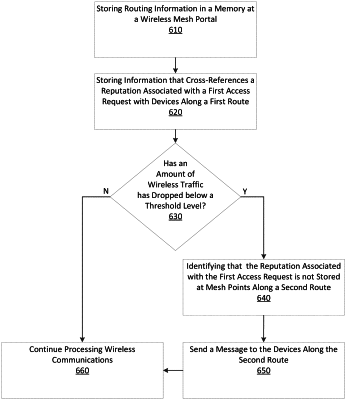| CPC H04W 84/18 (2013.01) [H04W 40/12 (2013.01); H04W 40/246 (2013.01)] | 21 Claims |

|
1. A method for distributing rating information, the method comprising:
storing in memory of a mesh portal device:
routing information that identifies one or more communication routes within a wireless mesh network, each of the communication routes including a set of one or more wireless mesh nodes, and
reputation information that correlates a reputation with a first access request for a website;
transferring the first access request along a first one of the communication routes that includes a first set of one or more wireless mesh nodes, wherein the wireless mesh nodes of the first route store the reputation information in cache memory;
identifying that an amount of communication traffic along the first route has dropped below a threshold level;
determining that the reputation correlated with the first access request is not stored at one or more wireless mesh nodes along a second route; and
transmitting the reputation information to the wireless mesh nodes along the second route when the amount of communication traffic is identified as having dropped below the threshold.
|